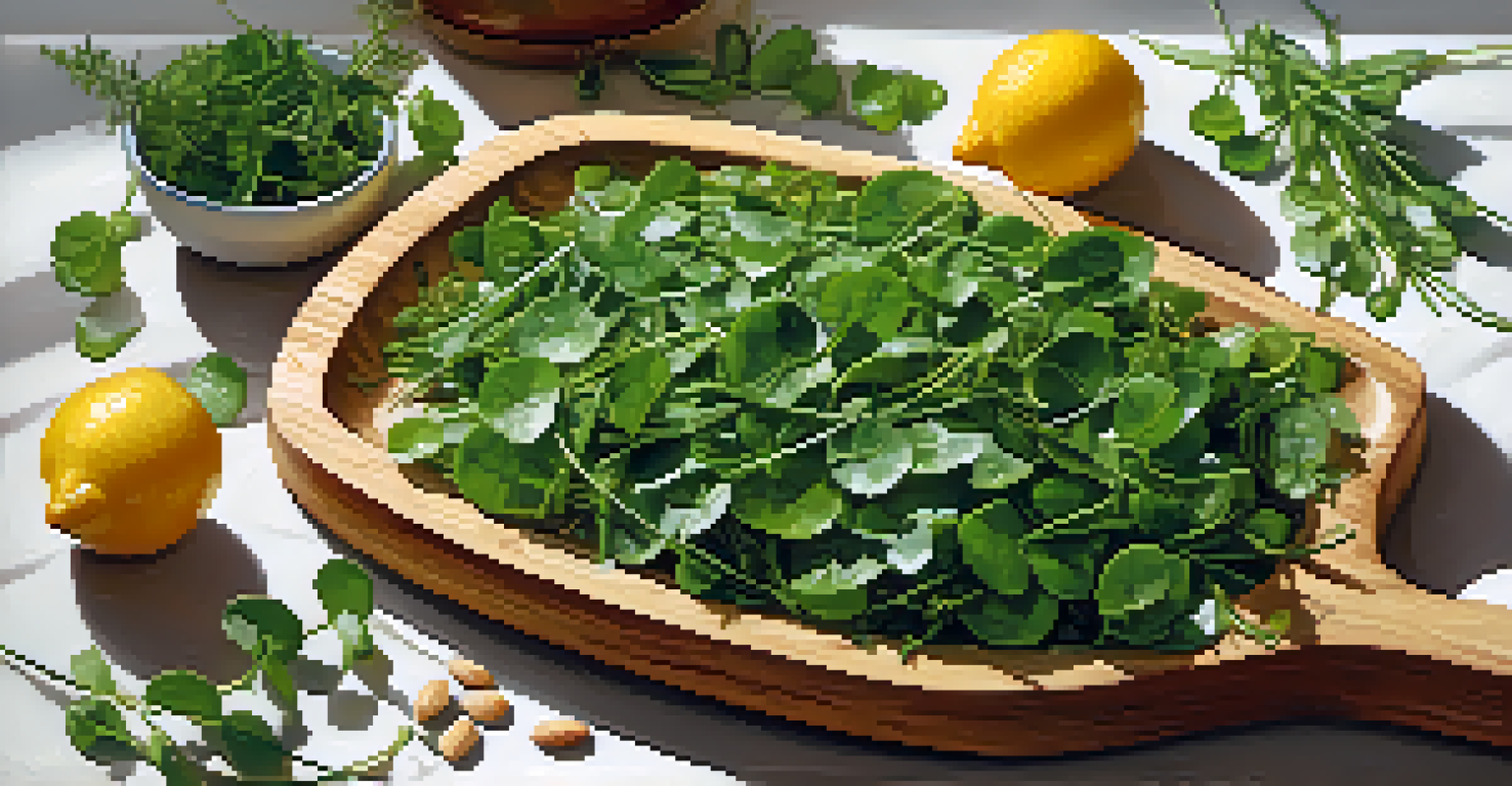Wild Greens: Identifying and Cooking with Edible Leaves

Understanding Wild Greens and Their Benefits
Wild greens are edible plants that grow in the wild, offering a nutritious addition to your diet. They not only enhance your meals but are also packed with vitamins, minerals, and antioxidants. Incorporating these greens can boost your immune system and improve overall health.
The greatest threat to our planet is the belief that someone else will save it.
Foraging for wild greens can be a rewarding experience. It connects you with nature and teaches you about local ecosystems. Plus, it’s a fun way to engage with your surroundings, making your meals more adventurous and sustainable.
In addition to their health benefits, wild greens can be a cost-effective choice. Instead of purchasing expensive salad greens at the store, you can forage for free, cultivating a deeper appreciation for the food you eat.
Common Edible Wild Greens to Look For
Some popular wild greens include dandelion, chickweed, and purslane. Dandelions are recognizable by their jagged leaves and bright yellow flowers, and they can be used in salads or sautéed as a side dish. Chickweed has small, star-like flowers and a mild flavor, making it a great addition to mixed green salads.

Purslane is another gem found in many gardens, characterized by its succulent leaves and slightly tangy taste. It’s excellent in salads or stir-fries. Other notable mentions include lamb’s quarters and nettles, each with unique flavors and culinary uses.
Wild Greens Offer Health Benefits
Incorporating wild greens into your diet enhances nutrition by providing vitamins, minerals, and antioxidants.
When foraging, always ensure you can positively identify the plants before consumption. Some wild greens may resemble toxic varieties, so it's important to consult reliable field guides or apps. Remember, safety first!
Foraging Tips for Wild Greens
When foraging for wild greens, timing and location matter. Early spring is often the best time to find tender young leaves, as they are more flavorful and nutritious. Look for areas away from pollution, such as gardens, parks, and woodlands.
Nature does not hurry, yet everything is accomplished.
Always be mindful of your surroundings and avoid areas treated with pesticides or chemicals. It’s best to forage in spots you know are safe and free from contaminants. Plus, consider asking for permission if you’re on private property.
Bring along a basket or cloth bag to collect your greens, and consider carrying a guidebook for identification. A small knife can also be handy for cutting greens at the base, ensuring you leave the root system intact for regrowth.
Preparing Wild Greens for Cooking
Before cooking with wild greens, it’s essential to clean them thoroughly. Rinse under cold water to remove dirt and insects, and soak them in a bowl if necessary. This step is crucial for ensuring a pleasant eating experience and maintaining food safety.
Once cleaned, you can prepare wild greens in various ways. Many can be eaten raw in salads, while others are best cooked to enhance their flavor and texture. Sautéing, steaming, or adding them to soups and stews are all excellent options.
Foraging Requires Safety Awareness
Always positively identify wild greens before consumption and avoid areas treated with chemicals to ensure safety.
Experiment with different cooking methods to find what you enjoy most. Some greens, like nettles, require blanching to remove their sting, while others, like dandelion leaves, can be enjoyed raw or cooked, depending on your taste preference.
Flavor Pairings for Wild Greens
Wild greens often have unique flavors that can be enhanced by pairing them with complementary ingredients. For instance, the bitterness of dandelion greens can be balanced with sweet dressings or served alongside creamy cheeses. This balance can elevate your dish and make it more enjoyable.
Herbs and spices also play a vital role in flavoring your wild green dishes. Garlic, lemon, and olive oil are fantastic additions that can bring out the natural taste of the greens. Don’t be afraid to experiment with bold flavors to find the perfect combination.
Additionally, consider incorporating nuts and seeds for added texture and health benefits. Toasted pine nuts or sunflower seeds can provide a delightful crunch, making your wild greens more satisfying and delicious.
Creative Recipes for Cooking Wild Greens
There are endless possibilities when it comes to cooking with wild greens. A simple recipe could be a dandelion salad mixed with citrus vinaigrette, topped with nuts for a crunchy finish. This dish showcases the greens while providing a burst of flavor.
Another idea is to create a wild greens pesto using chickweed or nettles. Blend them with nuts, garlic, olive oil, and Parmesan cheese for a delicious sauce that can be used on pasta, sandwiches, or as a dip. This recipe is a great way to incorporate greens into your meals creatively.
Sustainability is Key in Foraging
Harvest only what you need to preserve local ecosystems and ensure the availability of wild greens for future foragers.
Consider making a hearty soup with a mix of wild greens and seasonal vegetables. This comforting dish is not only nutritious but also an excellent way to use up any leftover greens you may have foraged. Let your creativity shine and have fun experimenting in the kitchen!
Safety and Sustainability in Foraging
While foraging for wild greens can be thrilling, it’s essential to prioritize safety and sustainability. Always ensure you’re confident in your plant identification skills, as consuming the wrong plants can lead to health issues. Educate yourself through workshops or local foraging groups.
Sustainability is key when foraging. Harvest only what you need, and leave plenty behind for the plant to regrow. This practice helps preserve local ecosystems and ensures that you and others can enjoy these greens for years to come.

Lastly, be aware of local regulations regarding foraging in public spaces. Some areas may have restrictions to protect native plants and wildlife. Respect these rules to help maintain the balance of nature while indulging in the joys of wild greens.